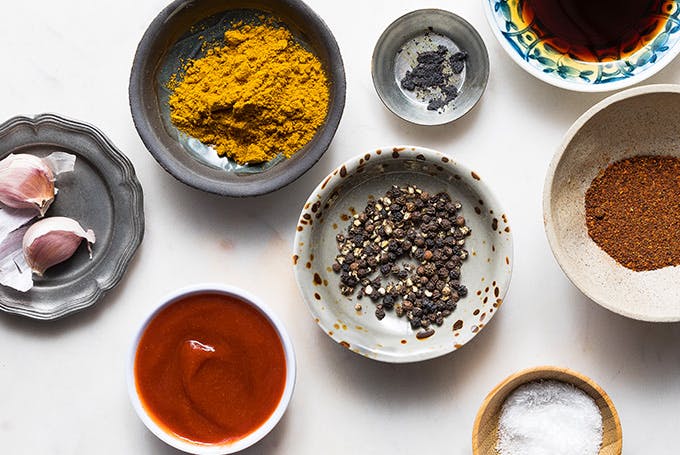The 8 Flavors That Define American Food
These are the ingredients that define American food
Meet the Chili Queens of San Antonio, a group of young women who popularized chili con carne as the country's first street food, but who have been practically erased from history. Food historian Sarah Lohman is telling their story, along with so many others, in her new book, Eight Flavors: The Untold Story of American Cuisine.
She investigates the nuances of food history that too often go unnoticed because they're the stories of immigrants, women and people of color by diving into the essential ingredients that define our ever-evolving culinary landscape. All are likely found in your kitchen in some form right now (vanilla, black pepper, curry powder, chili powder, garlic, soy sauce, MSG and sriracha). But the book isn't just a history of the ingredients: It's a history of the people behind them.
 Illustration: Peter Van Hyning
Illustration: Peter Van Hyning
Though Lohman's research took her from the Alamo to a soy sauce factory just north of New York City, her most unexpected journey was her tour of the Huy Fong Foods, Inc. factory and farm in southern California. (You may know it as the home of Sriracha.)
Every pepper that makes its way there and into the more than 20 million Sriracha bottles produced per year comes from the land of fourth-generation farmer, Craig Underwood. Every year, as the sauce's popularity continues to escalate, Underwood must grow more peppers, and hire more workers to help him. Lohman was struck by how Underwood emphasized the critical importance of immigrant and refugee labor in every step of the company's process.
"Anti-immigrant attitude doesn't gel with farm labor history and rural culture," Lohman points out. In fact, it's the complete opposite. "And without immigrants . . . America wouldn't have Sriracha," Lohman reminds us.
Of course, Sriracha isn't the only flavor we would miss without these key players. Keep turning back time and you'll see that every ingredient in Lohman's book has its own champion—or champions—who brought it into the mainstream. Take "Prince" Ranji Smile, the dazzling chef who introduced Americans to Indian curries in the early 1900s. If someone asked you to name the country's first celebrity chef, he probably wouldn't come to mind, but this Indian immigrant was making waves long before Food Network ever existed.
Smile's story is not an anomaly, but one that continues to be repeated today. Look at something as ubiquitous as garlic, which only saw a spike in popularity after four million Italians came to the U.S. between 1880 to 1920. And it was Chinese immigrants who introduced the often maligned MSG to the U.S., where it's now being embraced by the likes of Grant Achatz. Now, more than ever, it's important to acknowledge these stories.
Lohman warns that actively ignoring the paramount need of immigrant and refugee presence will have broader effects.
"If there's no labor to harvest and process crops, it will rot in the fields," she says. A report by UC Irvine and Temple University shows that there's an objective deficit of workers for low-skilled jobs. And without beloved (and immigrant-owned) bodegas, New Yorkers would falter without what the New York Times calls "common ground for neighbors from all over the globe."
"Immigrants don't just become American; America is also changed by immigrants," Lohman says.
—
Observing the nation's culinary past urges us to wonder what will happen to its future. What will be the ninth flavor to make its mark? Lohman points out a few rising trends, like matcha, pumpkin spice and smoke. Lior Lev Sercarz, spice blender and owner of La Boîte in NYC, agrees. "Everybody smokes everything," he says, "whether from a smoker or liquid smoke or all these gadgets that are everywhere." Keeping in mind that societal needs are ultimately the drivers of food trends, perhaps we'll see an influx of comfort food.

But it's not just about the next batch of ingredients that will leave their mark; it means expanding on what the first eight flavors have brought us as well. Not all curry powders are created equal—there's sweeter Japanese, familiar Indian, toasty Jamaican—and soy sauce can be aged in whiskey barrels. Sercarz believes we're likely to see an expansion of the nuances of these flavors, with young chefs featuring the flavors they're proud of from their homelands with local produce.
And while macarons with unicorn horns or hypnotic rainbow bagels may make your eyes roll, even viral trends have their place in history. A colorful bagel itself might not be the next vanilla bean, but Sarcarz notes that what results from the fad is more people taking interest in the bagels overall, in turn causing others to create artisanal versions of what's trendy. "The trends come and go: What's left behind is more interesting," he says.
Lohman agrees, with an even more laissez-faire stance. "Whatever makes people happy—and we all need a little joy sometimes."
Get in the American spirit with recipes highlighting these leading flavors:
• Red Wine and Garlic Steak Marinade
• Strawberry Peppercorn Cocktail
• Curry-Roasted Cauliflower
• Texas Red Chili
